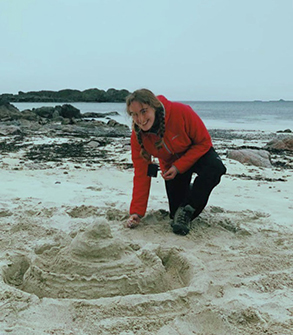Research Team

Current Students
Duncan Bristow, BSc Honours

- Start date: July 2017
- Project Title: Investigation into the structural relationship between the Massawa and Sofia orogenic gold deposits in Senegal, Western Africa
- Supervisors: Dr. Jonathan Cloutier
- Bio: Coming soon
Zoe Brown, MGeol

- Start date: July 2017
- Project Title: Making the Grade: controls on mineralisation at the Vidlin Ness low-grade stratabound Cu-Zn-Pb deposit, Shetland
- Supervisor: Dr. Jonathan Cloutier
- Bio: I'm from the Scottish Highlands and I'm in the 5th year of my integrated Masters degree (MGeol) at the Unversity of St Andrews. Through my studies at St Andrews I have become particularly interested in igneous and metamorphic petrology, economic geology, GIS and fieldwork. I hope to pursue a career in mineral exploration. My MGeol dissertation focusses on a volcanogenic massive sulphide Cu-Pb-Zn deposit exposed on the Shetland mainland. It will delve into the grade, structural relationship, tectonic setting and deformational history of the deposit, in order to understand the controls on mineralisation. I will also reinvestigate the economic potential of the deposit. My dissertation is partly funded by GreenOre Gold Plc.
James Edwards, PhD candidate

- Start date: September 2017
- Project Title: Source, timing, and genesis of Scottish orogenic gold deposits
- Supervisors: Dr. Jonathan Cloutier (University of St Andrews), Dr. William McCarthy (University of St Andrews), Prof Adrian Boyce (SUERC), Dr. Darren Mark (SUERC) and Mr. Chris Sangster (Scotgold Resources Ltd)
- Funding: NERC DTP CASE studenship and Scotgold Resources Ltd.
- Bio: I graduated in 2015 from University College London with an integrated masters degree, and I spent my final year investigating the mineralogical hosts of F in Precambrian basement rock and its regolith in Zimbabwe as my independent research project. I enjoyed completing the project, analysing the samples and linking the findings to the wider world. After a break of a couple of years away from geology, I became interested in doing a PhD, specifically a project investigating economic geology and also involving petrology and igneous geology. This has led me start this PhD project on Scottish gold. My research concerns characterising gold bearing veins of the mineralised system and aims to identify critical parameters capable of distinguishing between ore-forming and non-ore forming processes and generate an exploration model. My PhD project is in partnership with SUERC and is CASE-supported by Scotgold as well as associated with the National Productivity Investment Fund.
Nicky Horsburgh, PhD candidate

- Start date: September 2015
- Project Title: Laser and X-Ray Luminescence of REE minerals
- Supervisors: Prof. Adrian Finch (University of St Andrews), Prof. Frances Wall (Camborne School of Mines), Prof. Animesh Jha (University of Leeds), and Dr. Jonathan Cloutier (University of St Andrews)
- Sponsors: SoS Minerals (NERC) and University of St Andrews
- Bio: I completed my undergraduate study at the University of St Andrews in 2009, and since graduating I have been working as an Engineering Geologist. I worked on the Scottish NW trunk road network to reduce the impacts and risks of hazards, specialising in the prevention, mitigation and remediation of landslides and rock-falls.
I am now working on a PhD funded jointly by the University and the SoS RARE consortium, which I started in 2015. I am investigating laser and X-Ray luminescence of rare earth element (REE) ore minerals. I am looking at whether luminescence can fingerprint REE minerals and how rare earth elements in structures affect their fluorescence. The long term goal is to determine whether fluorescence or other forms of mineral spectroscopy can be adapted to develop 'smart' sorting methods. This would allow the efficiency of some of the most important extraction methods in modern technology to be greatly enhanced.
Simon Jones, PhD candidate

- Start date: September 2016
- Project Title: Alteration and fluid flow associated with sediment-hosted stratiform copper mineralisation in the Midcontinent Rift System
- Supervisors: Dr. Jonathan Cloutier (University of St Andrews), Dr. Tim Raub (University of St Andrews) and Dr. Tony Prave (University of St Andrews)
- Funding: First Quantum Minerals Ltd. and Highland Copper Company Inc.
- Bio: I grew up on the "Jurassic Coast" in southern England and developed a love for geology from an early age. I completed my undergraduate degree at Imperial College, London, in 2007. During my BSc I worked in the oil industry and on volcanic massive sulphide deposits in the Oman ophiolite. I was fascinated by how metallic mineral deposits form and I decided to pursue a career in mineral exploration.
Since graduating I have been working for First Quantum Minerals as an Exploration Geologist. I've been fortunate to have worked in several different countries, on a variety of different deposit styles, using a range of exploration techniques. I have always been intrigued by sediment-hosted copper deposits and after several stints in and around the Central African Copperbelt I decided to do a PhD project on this deposit type.
My research concerns the fluid flow that formed the 1.1 Ga White Pine deposit in Michigan and is supervised by Jonathan Cloutier, Tim Raub and Tony Prave. It is funded by my (previous) employer who plan on getting me back in several years' time as an expert on the subject!.
Calum Lyell, PhD candidate

- Start date: September 2017
- Project Title: Evolving the genetic model for the Cononish Au deposit: from prospect to mine
- Supervisors: Prof Adrian Boyce (SUERC), Dr. Darren Mark (SUERC), Dr. Jonathan Clooutier (University of St Andrews) and Mr Richard Gray (Scotgold Resources Ltd)
- Funding: NERC DTP CASE studenship and Scotgold Resources Ltd.
- Bio: Coming soon
Isabel McDonald, BSc Honours

- Start date: July 2017
- Project Title: 3D mapping and modelling of a Barite Sedimentary Exhalative Deposit, Duntanlich, Aberfeldy
- Supervisor: Dr. Jonathan Cloutier
- Bio:
My Name is Isabel McDonald and I am a Senior Honours student at the University of St Andrews, with a keen interest in economic geology and mineralogy. My dissertation is based on the Duntanlich Barite deposit in Aberfeldy, Perthshire. In order to explore the nature of this unusually rich barite deposit, I will be using varied approaches to analyse it.
During this project, I will log cores to generate a 3D model using Leapfrog Geo, and analyse the petrography of the host rock west, east and central in the ore body. There will be a petrographical and geochemical focus on the mineralised zones where the ore has not appeared in economic quantities. In addition, the magnetic susceptibility of sections of core will be measured to see whether pyrite had converted to phyrrotite, which could be due to metamorphism or may indicate conditions on formation of ore. Finally, sulphur isotopes may be used to see the temperature conditions of the seawater on time of ore body formation.
Krzysztof Sokol, PhD candidate

- Start date: September 2017
- Project Title: High Field Strength Element Mobility in Late-Stage Fluids, Gardar Rift, South Greenland
- Supervisors: Prof. Adrian Finch (University of St Andrews), Dr. Madeleine Humphreys (University of Durham) and Dr. Jonathan Cloutier (Univertsity of St Andrews)
- Funding: NERC DTP studenships.
- Bio: As a Polish national, I joined the geological community by completing an integrated undergraduate masters MGeoscience at Keele University, Staffordshire, graduating with First Class Honours. There I learned the complexity of petrographic and mineralogical analyses while studying igneous rocks from the Aeolian Islands, Italy and subsequently completed my masters thesis detailing the petrology of Tezhsar Alkaline Complex within the Armenian collision zone.
My PhD work at the University of St Andrews entails looking at the metasomatically altered, "fenitised", country rocks associated with the Proterozoic alkaline intrusions of Gardar Province, Greenland. I study the behaviour and variations in alteration to determine the nature of late-stage fluids that cause crystallisation of alkali pyroxenes and amphiboles in place of quartz, as these fluids transport commercially important rare earth (REEs) and high field strength elements (HFSEs).
New insights to the element mobilisation mechanisms will tie into the ongoing research of the SoS Rare & High-Tech-Alk-Carb consortia and will aid future exploration for REE & HFSE deposits. The project is funded via NERC DTP.
Abigail Urquhart, BSc Honours

- Start date: July 2017
- Project Title: Characterizing the Palaeohighs of the Maureen Formation in the Central North Sea
- Supervisor: Dr. Jonathan Cloutier
- Bio:
I'm from Aberdeen and I am an undergraduate in my final year at St Andrews and am currently working on my dissertation project with Jonathan and the data for has been provided by Maersk Oil, UK. The aim of this project is to investigate the variability of the Palaeocene - Lower Eocene series rocks in the Culzean field in the Central North Sea and to try to further understand the depositional environment this sequence. Whilst drilling the 22/25a-C5 well through the Forties to Maureen section it was noted that there was a variation in the lithologies expected for that area compared to previously drilled wells. The actual drilling performance was also affected by this change in rock type with 22/25a-C5 being drilled 500% faster compared to the other wells. When looking in particular at the Maureen Formation it would be typical to see a clay-rich facies with some reworked chalk and very little sand-rich layers. In the 22/25a-C5 well the Maureen is thicker and there is a distinct paleohigh present where a sand-rich body marks the top of the formation. This is not seen in any of the other wells drilled in the area and raises questions about the provenance of the sand-rich section.
By using data gathered from the surrounding wells in the Culzean area and other proximal fields I hope to correlate vertical well-sections across horizons to create a comprehensive data set. Relating previously published data on this area will also allow for a further understanding of the Maureen in C5 relative to the other Culzean wells.